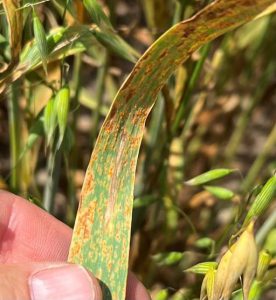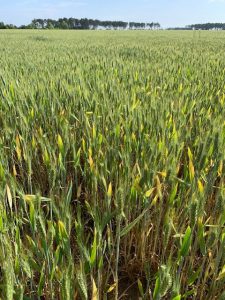Rome Ethredge – UGA Interim Grains and Soybean Agronomist
Oat Rust
 We are seeing some rust disease in oats now and it can be serious. Here are Dr. Alfredo Martinez’s comments, “Crown/leaf rust, caused by the fungal pathogen Puccinia coronata f. sp. avenae, is one of the most problematic and damaging diseases of oats in Georgia. Yield losses associated with crown/leaf rust range from slight/moderate to full crop failure.”
We are seeing some rust disease in oats now and it can be serious. Here are Dr. Alfredo Martinez’s comments, “Crown/leaf rust, caused by the fungal pathogen Puccinia coronata f. sp. avenae, is one of the most problematic and damaging diseases of oats in Georgia. Yield losses associated with crown/leaf rust range from slight/moderate to full crop failure.”
We really don’t want the rust to get on the flag leaf. There are many fungicides labeled for oats, check with Dr. Martinez for a list and effectiveness. He will include Oat Disease controls in the upcoming 2023 Ga Pest control Handbook.
There are some varieties that are resistant to rust, but over time the rust changes and they become susceptible, so scouting is important.
–
Wheat Flag Leaves Drying
I’ve had several comments and photos sent to me this week, a couple are below, concerning wheat for grain where the leaves and even flag leaves are drying or dying. Several things or likely a combination can be causing this, the most common being dry, windy weather. This seems to be occurring most in sandy areas of the field that would be most susceptible to drying out. I’ve also seen it in excessively wet areas of the field where the roots aren’t doing well.
Other possibilities include running out of nitrogen (especially in sandy fields when the side dress was done early or there has been lots of rain). Fusarium foot rot is possible especially if the field has often been planted to wheat. Barley Yellow Dwarf disease could also be the issue but usually there’s some reddish color with that.
Soon, plants will be naturally going back as they mature but we’re a little ahead of that, some varieties may senesce a little earlier or show these symptoms worse.
- Federal Estate Tax and Gift Tax Limits Announced For 2026 - December 19, 2025
- Why Do I Have So Many Open Cows? Causes of Reproductive Failure - December 19, 2025
- Wiregrass Cotton Expo Offers Resources, Research, & Real Solutions for Growers in Southeast – January 22 - December 19, 2025


